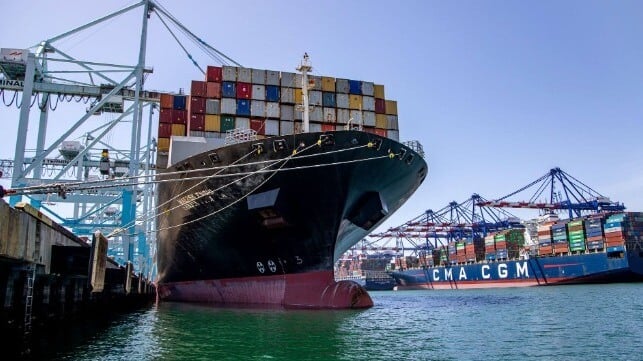Shipping Stocks Take Off After Trump's Tariff Rollback

Just in time for the peak container shipping season on the China-U.S. transpacific route, the Trump administration has negotiated a deal with the government of China to relax unprecedented tariffs on bilateral trade. The U.S. will drop its net tariffs on Chinese goods from 145 percent down to 30 percent, well below the levels that many market participants predicted. China will drop its tariffs on U.S. goods from 125 percent down to 10 percent.
The temporary agreement is valid for at least the next 90 days while the two sides discuss permanent terms, giving U.S. importers a window to stock up on Chinese-made goods for the back-to-school and Christmas holiday shopping seasons.
After April 2, facing unprofitable tariff levels, many American importers had stopped shipping goods out of China to await more favorable developments, hitting U.S. inventories and Chinese consumer-goods manufacturers hard. The slowdown will now shift in reverse as retailers move to rebuild stock. "Get ready for a shipping boom," said Flexport CEO Ryan Petersen in a statement early Monday.
Stocks soared on news of the agreement, with the Nasdaq jumping by four percent by midafternoon. The Dow and the S&P 500 both gained about three percent. All three indices have now regained all of the losses incurred after the White House's April 2 tariff announcement; China-dependent consumer retail stocks showed particular strength, reflecting renewed confidence in their ability to source imported goods. Stock for toymaker Mattel jumped 10 percent, Best Buy rose six percent, and discount chain Five Below soared 20 percent.
"We believe new highs for the market and tech stocks are now on the table in 2025," said Dan Ives of Wedbush Securities, speaking to the WSJ. "This morning is a huge win for the bulls."
Trade-dependent container shipping stocks took off, regaining much of the lost ground of recent weeks. Matson, the Jones Act carrier that operates a specialty service from East Asia to the U.S. West Coast, jumped 19 percent in midday trading. Maersk's OTC stock traded up 10 percent, Hapag-Lloyd was up more than two percent, NYK by nearly four percent, and Yang Ming by one percent. Zim was a clear winner, with shares up by 14 percent.
“We expect bookings from China to the U.S. to increase, which should help us . . . into peak season," Hapag-Lloyd told Reuters in a statement.
The reduced level of activity at West Coast gateway ports is still built into the forecast through the end of May: the dozens of blanked sailings that ocean carriers implemented on ex-China routes are a guarantee of fewer ships with less cargo arriving LA/Long Beach in the immediate term. The first San Pedro port activity rebound could be expected in two to three weeks at the earliest, reflecting the minimum transit time needed for a box from eastern China to reach California. Some analysts predict that the San Pedro ports could swing from light activity to significant congestion by midsummer as retailers rush to bring cargo in from China at comparatively affordable tariff levels.
Gene Seroka, head of the Port of LA, told the Wall Street Journal that he was less bullish about a spike in shipping volume. “I don’t see all of the normal cargo coming back to the levels that we had witnessed in recent weeks and months,” Seroka said. “Reason being, you’re not going to be frontloading at 30 percent [tariffs].”
Veteran shipping analyst Peter Sand concurred. :It must not be ignored there is still a 30% tariff on imports from China to the US and this will be prohibitive for some businesses with lower-margin goods, so there will still be an adverse impact on ocean container shipping demand," he said in a research note Monday. "It may also take shippers a little time to ramp up sourcing and manufacturing in China again if they took the foot off the gas following the 145 percent tariffs announced on 9 April."
